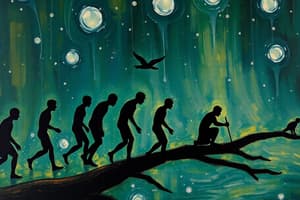Podcast
Questions and Answers
What is the first step in the process of natural selection?
What is the first step in the process of natural selection?
- Changes in heritable characteristics
- Differential reproduction
- Variation (correct)
- Struggle
Which concept countered Darwin's theory due to its impact on variation?
Which concept countered Darwin's theory due to its impact on variation?
- Natural selection
- Differential reproduction
- Mendelian inheritance
- Blending inheritance (correct)
What does differential reproduction depend on in the context of natural selection?
What does differential reproduction depend on in the context of natural selection?
- Genetic mutation rates
- Environmental factors
- Heritable variation (correct)
- Population size
What does the struggle for existence in natural selection refer to?
What does the struggle for existence in natural selection refer to?
What outcome does genetic variation ultimately lead to, according to the natural selection process?
What outcome does genetic variation ultimately lead to, according to the natural selection process?
What is the main purpose of meiosis in sexual reproduction?
What is the main purpose of meiosis in sexual reproduction?
What distinguishes the daughter cells produced during meiosis from those produced during mitosis?
What distinguishes the daughter cells produced during meiosis from those produced during mitosis?
During which phase of meiosis does the chromosome number get halved?
During which phase of meiosis does the chromosome number get halved?
What would happen if gametes remained diploid in sexual reproduction?
What would happen if gametes remained diploid in sexual reproduction?
How does the fusion of haploid gametes affect the chromosome number of an organism?
How does the fusion of haploid gametes affect the chromosome number of an organism?
What process describes the separation of homologous chromosomes during Meiosis I?
What process describes the separation of homologous chromosomes during Meiosis I?
What is produced at the end of Meiosis II?
What is produced at the end of Meiosis II?
During which phase of Meiosis I do homologous chromosomes form tetrads?
During which phase of Meiosis I do homologous chromosomes form tetrads?
Which phase of Meiosis II involves chromosomes aligning at the metaphase plate?
Which phase of Meiosis II involves chromosomes aligning at the metaphase plate?
What is the chromosome composition at the end of Telophase I?
What is the chromosome composition at the end of Telophase I?
Which statement is true regarding Interphase II?
Which statement is true regarding Interphase II?
During which phase of meiosis are sister chromatids pulled apart?
During which phase of meiosis are sister chromatids pulled apart?
How many chromatids would be present in a cell that has undergone Meiosis I but not Meiosis II yet?
How many chromatids would be present in a cell that has undergone Meiosis I but not Meiosis II yet?
How many chromosomes does the plant in the diagram have?
How many chromosomes does the plant in the diagram have?
What process does the diagram most likely represent?
What process does the diagram most likely represent?
What did Mendel suggest regarding the alleles from dissimilar alleles meeting?
What did Mendel suggest regarding the alleles from dissimilar alleles meeting?
How does meiosis contribute to diversity in gametes?
How does meiosis contribute to diversity in gametes?
What is the total number of unique combinations of gametes possible for humans due to meiosis?
What is the total number of unique combinations of gametes possible for humans due to meiosis?
What distinguishes daughter cells produced by meiosis from those produced by mitosis?
What distinguishes daughter cells produced by meiosis from those produced by mitosis?
Which of the following is NOT an implication of meiosis for diversity of gametes?
Which of the following is NOT an implication of meiosis for diversity of gametes?
What process allows for the unique combination of alleles in gametes?
What process allows for the unique combination of alleles in gametes?
What is meant by particulate inheritance as discovered by Gregor Mendel?
What is meant by particulate inheritance as discovered by Gregor Mendel?
What defines a diploid organism?
What defines a diploid organism?
Which of the following statements is true regarding alleles?
Which of the following statements is true regarding alleles?
How many homologous chromosome pairs do humans typically have?
How many homologous chromosome pairs do humans typically have?
Which process is responsible for producing gametes in organisms?
Which process is responsible for producing gametes in organisms?
What does the term 'locus' refer to in genetics?
What does the term 'locus' refer to in genetics?
How does independent assortment impact genetic variation?
How does independent assortment impact genetic variation?
Why are parents not like buckets of paint in terms of genetic inheritance?
Why are parents not like buckets of paint in terms of genetic inheritance?
Flashcards are hidden until you start studying
Study Notes
Understanding Natural Selection
- Evolution is a process of change in heritable characteristics of a population over an extended period of time
- Darwin's theory of natural selection explains this phenomenon
- Natural selection is a mechanism driving evolution and operates based on:
- Variation: Individuals within a population exhibit differences in their traits
- Heritable variation: These variations are passed on to offspring
- Struggle: Organisms compete for resources and survival
- Differential reproduction: Individuals with advantageous traits are more likely to survive and reproduce, passing on their beneficial traits
- Continuous variation is crucial for natural selection to operate effectively
Addressing Darwin's Dilemma
- Darwin lacked an understanding of inheritance mechanisms
- He faced a challenge, as blending inheritance, the prevalent view at the time, contradicted his theory
- Blending inheritance would counteract the variation necessary for natural selection to work
Unveiling Mendel’s Solutions
- Gregor Mendel's work in inheritance provided solutions to Darwin's dilemma
- Mendel's discoveries:
- Segregation: Alleles for a trait separate during gamete formation
- Independent Assortment: Alleles for different traits assort independently of one another
- Understanding Mendel's solutions requires understanding meiosis, the process of cell division that produces gametes (sperm and egg cells)
- Meiosis involves two rounds of cell division, resulting in haploid gametes with half the number of chromosomes as the parent cell
Meiosis: The Key to Inheritance
- Meiosis ensures genetic diversity by shuffling parental chromosomes
- Meiosis involves several phases:
- Interphase: Chromosomes replicate, forming sister chromatids
- Prophase I: Homologous chromosomes pair up to form tetrads
- Metaphase I: Tetrads align at the metaphase plate, ready for separation
- Anaphase I: Homologous chromosomes are pulled apart, each migrating to opposite poles of the cell
- Telophase I: Two haploid daughter cells are formed, each containing one chromosome from each homologous pair
- Interphase II (optional): May or may not occur with no further DNA replication
- Prophase II: Chromosomes condense and migrate toward the metaphase plate
- Metaphase II: Chromosomes line up at the metaphase plate
- Anaphase II: Sister chromatids separate, each migrating to opposite poles
- Telophase II: Four haploid daughter cells are formed, each containing a unique combination of chromosomes
Implications of Meiosis for Genetic Diversity
- Meiosis generates diverse gametes through three mechanisms:
- Segregation: Alleles separate during gamete formation, ensuring variation in offspring
- Independent Assortment: Alleles for different traits assort independently, increasing the number of possible gamete combinations
- Recombination: Exchange of genetic material between homologous chromosomes during Prophase I, further increasing genetic diversity
Significance of Mendel’s Findings
- Mendel's findings revolutionized our understanding of inheritance, resolving Darwin's dilemma
- They demonstrated that variation is preserved and amplified through segregation and independent assortment during meiosis
- Meiosis explains how variation is maintained and passed down from generation to generation, supporting natural selection as the driving force behind evolution.
Studying That Suits You
Use AI to generate personalized quizzes and flashcards to suit your learning preferences.




